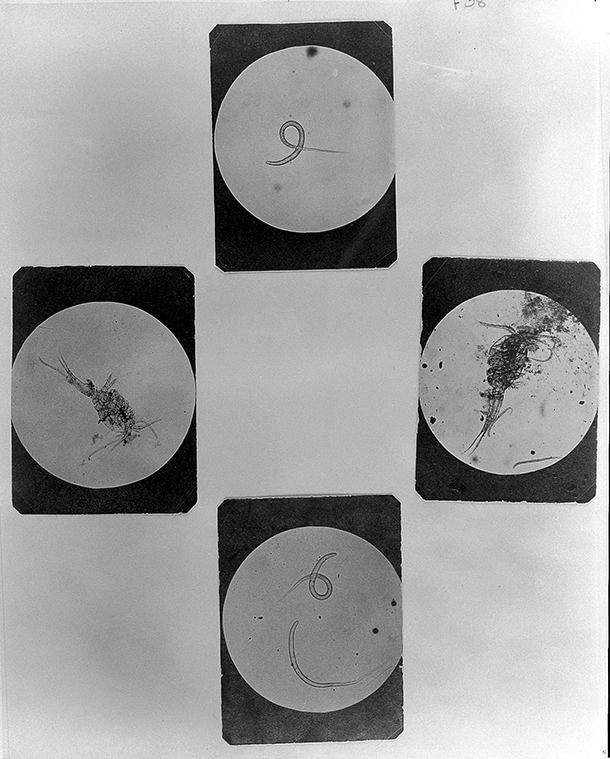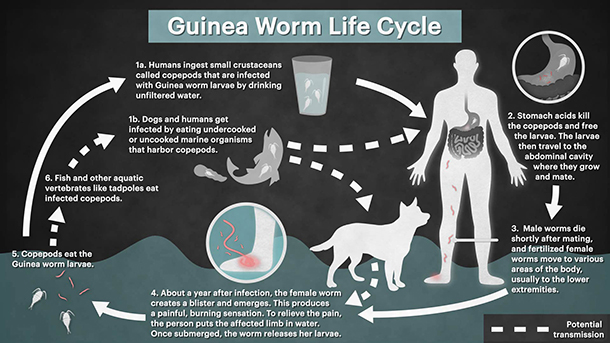Science Note: A Parasite Setback
Air Date: Week of September 2, 2016

Microphotographs showing development of the guinea worm. (Photo: Wellcome Images, Wikimedia Commons)
The Guinea worm, an unpleasant parasite that once infected millions of people in Africa, was nearly eradicated. But the worm, which grows up to three feet long inside the body, and causes pain and suffering as it emerges through its host’s skin, is hanging on by infecting dogs, as Living on Earth’s Don Lyman reports in this note on emerging science.
Transcript
CURWOOD: Just ahead...new concerns about drug resistant diseases, but first, this note on Emerging Science from Don Lyman.
LYMAN: The Guinea worm is a particularly unpleasant parasite. People pick up the larvae by drinking unfiltered water, or by eating undercooked or raw fish. The larvae grow into adults and mate in the abdomen. The worms can grow up to three feet long and emerge through a painful blister in the skin.
The parasite was on the verge of eradication, reduced from about 3.5 million cases in 21 countries in 1986, to just 11 cases so far this year. But now the Guinea worm appears to be on the rebound. The reason? Dogs.

Guinea worm life cycle (Photo: Boston Globe, Hyacinth Empinado/STAT).
In the northern African country of Chad, 498 infected dogs were found from January to May of 2016, a 150 percent increase from the same period last year. And health experts expect infected dog numbers to exceed 600 by the end of this year.
Since dogs roam freely, they can potentially spread Guinea worm larvae to water sources used by humans. The pain when the worm emerges causes the infected host to seek relief in water, where the female worm exits the victim’s body, releases her larvae, and the worms’ life cycle begins again.
So health workers are paying people $20 to keep dogs infected with Guinea worms tied on a leash until the parasite emerges. The Carter Center, which originally helped launch the Guinea worm eradication effort, reported that 81 percent of the 498 infected dogs) earlier this year had been isolated and contained. But that still left 95 dogs which possibly infected water sources.
Scientists and health workers say it’s a big task ahead of them trying to eradicate Guinea worms from dogs, but they believe it can be done within a few years. Then the Guinea worm could join smallpox as the second human disease ever to no longer afflict people.
That’s this week’s note on emerging science. I’m Don Lyman.
Links
STAT News: “Guinea worm, on the brink of eradication, puts up a surprisingly stubborn fight”
The Carter Center’s Guinea Worm Eradication Program
Living on Earth wants to hear from you!
Living on Earth
62 Calef Highway, Suite 212
Lee, NH 03861
Telephone: 617-287-4121
E-mail: comments@loe.org
Newsletter [Click here]
Donate to Living on Earth!
Living on Earth is an independent media program and relies entirely on contributions from listeners and institutions supporting public service. Please donate now to preserve an independent environmental voice.
NewsletterLiving on Earth offers a weekly delivery of the show's rundown to your mailbox. Sign up for our newsletter today!
 Sailors For The Sea: Be the change you want to sea.
Sailors For The Sea: Be the change you want to sea.
 The Grantham Foundation for the Protection of the Environment: Committed to protecting and improving the health of the global environment.
The Grantham Foundation for the Protection of the Environment: Committed to protecting and improving the health of the global environment.
 Contribute to Living on Earth and receive, as our gift to you, an archival print of one of Mark Seth Lender's extraordinary wildlife photographs. Follow the link to see Mark's current collection of photographs.
Contribute to Living on Earth and receive, as our gift to you, an archival print of one of Mark Seth Lender's extraordinary wildlife photographs. Follow the link to see Mark's current collection of photographs.
 Buy a signed copy of Mark Seth Lender's book Smeagull the Seagull & support Living on Earth
Buy a signed copy of Mark Seth Lender's book Smeagull the Seagull & support Living on Earth

